engine TOYOTA HILUX 2023 Owners Manual
[x] Cancel search | Manufacturer: TOYOTA, Model Year: 2023, Model line: HILUX, Model: TOYOTA HILUX 2023Pages: 810, PDF Size: 131.54 MB
Page 301 of 810
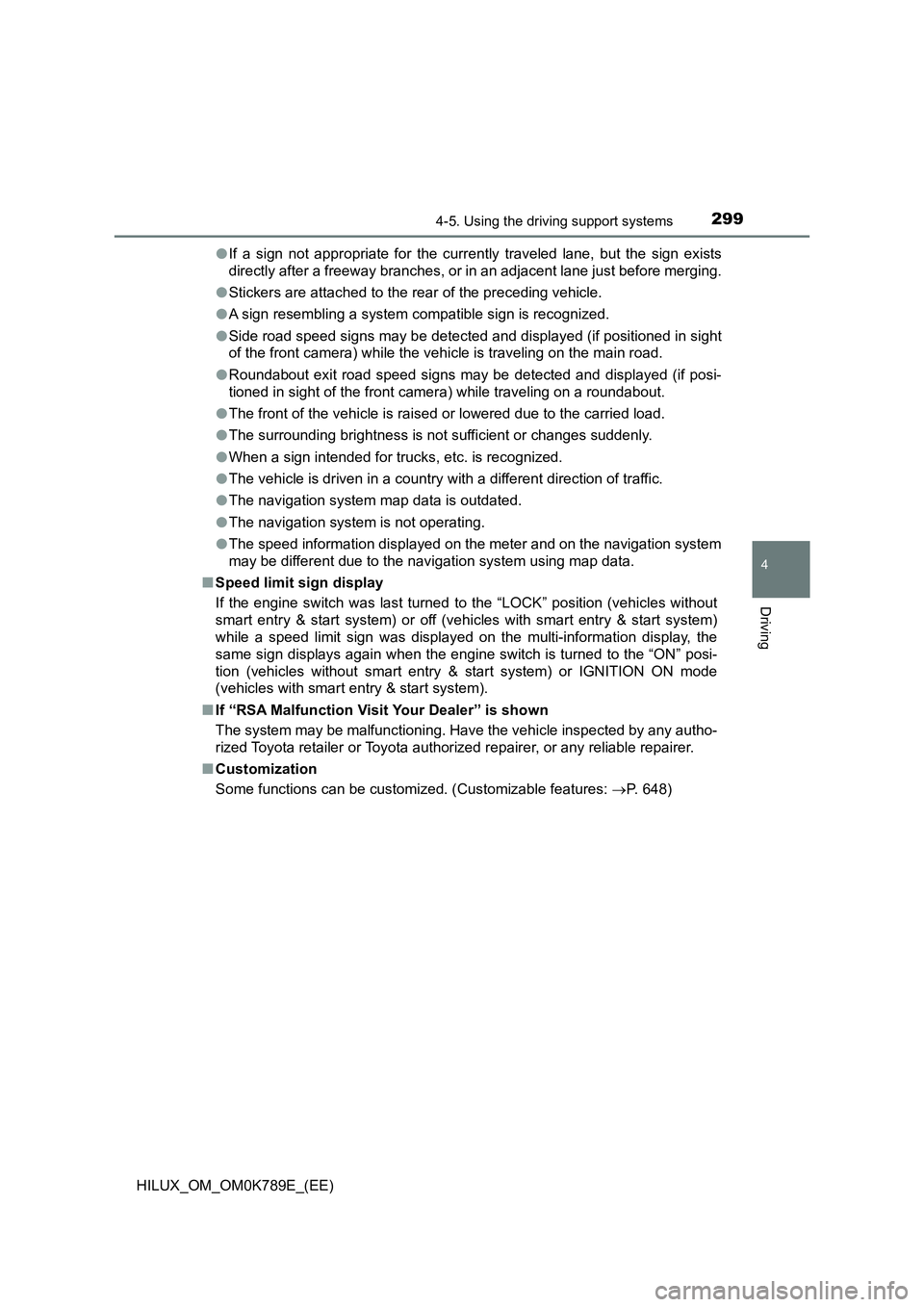
2994-5. Using the driving support systems
4
Driving
HILUX_OM_OM0K789E_(EE)
● If a sign not appropriate for the currently traveled lane, but the sign exists
directly after a freeway branches, or in an adjacent lane just before merging.
● Stickers are attached to the rear of the preceding vehicle.
● A sign resembling a system compatible sign is recognized.
● Side road speed signs may be detected and displayed (if positioned in sight
of the front camera) while the vehicle is traveling on the main road.
● Roundabout exit road speed signs may be detected and displayed (if posi-
tioned in sight of the front camera) while traveling on a roundabout.
● The front of the vehicle is raised or lowered due to the carried load.
● The surrounding brightness is not sufficient or changes suddenly.
● When a sign intended for trucks, etc. is recognized.
● The vehicle is driven in a country with a different direction of traffic.
● The navigation system map data is outdated.
● The navigation system is not operating.
● The speed information displayed on the meter and on the navigation system
may be different due to the navigation system using map data.
■ Speed limit sign display
If the engine switch was last turned to the “LOCK” position (vehicles without
smart entry & start system) or off (vehicles with smart entry & start system)
while a speed limit sign was displayed on the multi-information display, the
same sign displays again when the engine switch is turned to the “ON” posi-
tion (vehicles without smart entry & start system) or IGNITION ON mode
(vehicles with smart entry & start system).
■ If “RSA Malfunction Visit Your Dealer” is shown
The system may be malfunctioning. Have the vehicle inspected by any autho-
rized Toyota retailer or Toyota authorized repairer, or any reliable repairer.
■ Customization
Some functions can be customized. (Customizable features: P. 648)
Page 314 of 810
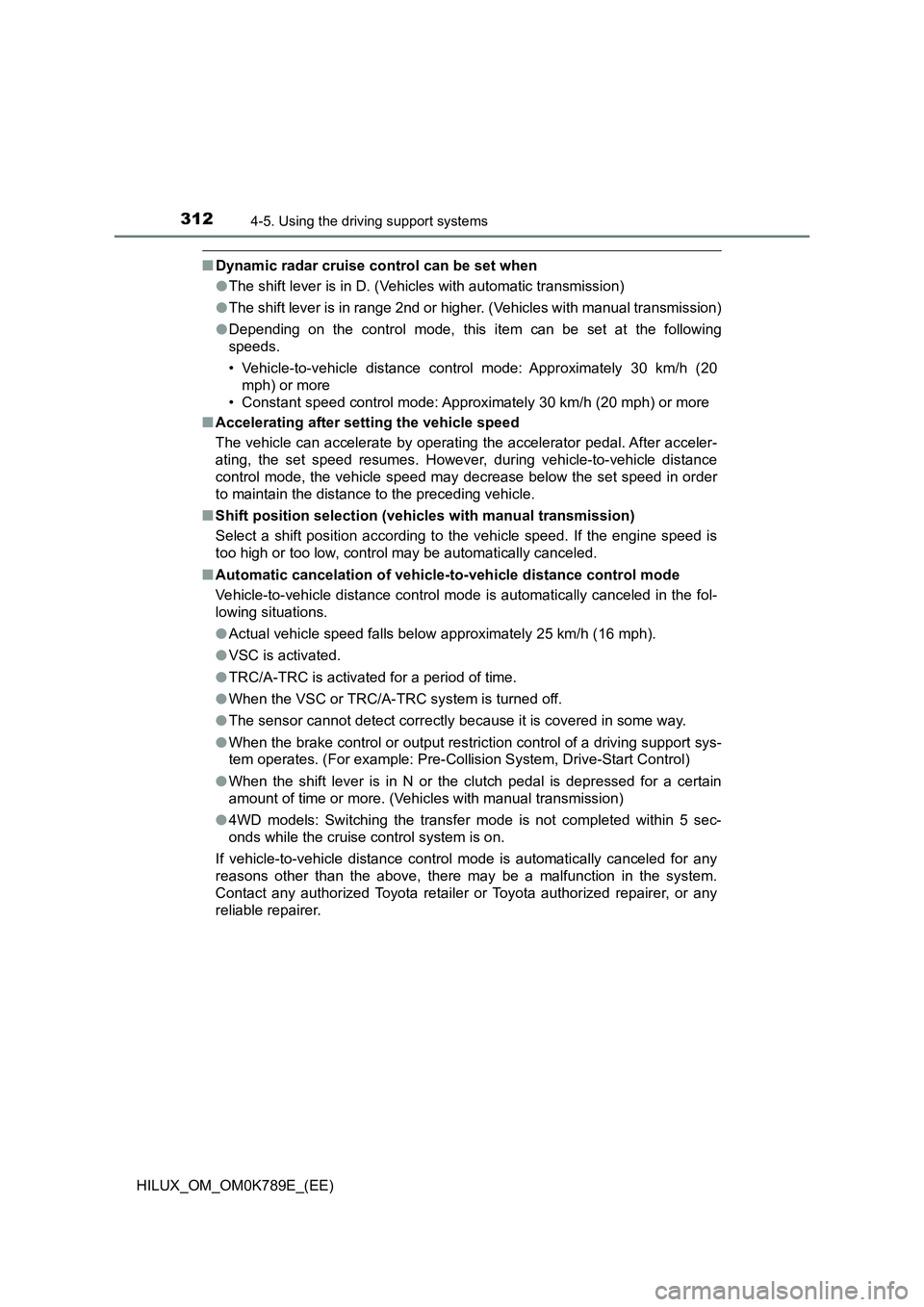
3124-5. Using the driving support systems
HILUX_OM_OM0K789E_(EE)
■Dynamic radar cruise control can be set when
● The shift lever is in D. (Vehicles with automatic transmission)
● The shift lever is in range 2nd or higher. (Vehicles with manual transmission)
● Depending on the control mode, this item can be set at the following
speeds.
• Vehicle-to-vehicle distance control mode: Approximately 30 km/h (20
mph) or more
• Constant speed control mode: Approximately 30 km/h (20 mph) or more
■ Accelerating after setting the vehicle speed
The vehicle can accelerate by operating the accelerator pedal. After acceler-
ating, the set speed resumes. However, during vehicle-to-vehicle distance
control mode, the vehicle speed may decrease below the set speed in order
to maintain the distance to the preceding vehicle.
■ Shift position selection (vehicles with manual transmission)
Select a shift position according to the vehicle speed. If the engine speed is
too high or too low, control may be automatically canceled.
■ Automatic cancelation of vehicle-to-vehicle distance control mode
Vehicle-to-vehicle distance control mode is automatically canceled in the fol-
lowing situations.
● Actual vehicle speed falls below approximately 25 km/h (16 mph).
● VSC is activated.
● TRC/A-TRC is activated for a period of time.
● When the VSC or TRC/A-TRC system is turned off.
● The sensor cannot detect correctly because it is covered in some way.
● When the brake control or output restriction control of a driving support sys-
tem operates. (For example: Pre-Coll ision System, Drive-Start Control)
● When the shift lever is in N or the clutch pedal is depressed for a certain
amount of time or more. (Vehicles with manual transmission)
● 4WD models: Switching the transfer mode is not completed within 5 sec-
onds while the cruise control system is on.
If vehicle-to-vehicle distance control mode is automatically canceled for any
reasons other than the above, there may be a malfunction in the system.
Contact any authorized Toyota retailer or Toyota authorized repairer, or any
reliable repairer.
Page 326 of 810

3244-5. Using the driving support systems
HILUX_OM_OM0K789E_(EE)
■Toyota parking assist-sensor can be operated when
● The engine switch is in the “ON” position (vehicles without smart entry &
start system) or IGNITION ON mode (vehicles with smart entry & start sys-
tem).
● Front corner sensor:
• The shift lever is in other than P.
• The vehicle speed is approximately 10 km/h (6 mph) or less.
● Rear corner and rear center sensors:
The shift lever is in R.
■ Sensor detection information
● The sensor’s detection areas are limited to the areas around the vehicle’s
bumper.
● Depending on the shape of the object and other factors, the detection dis-
tance may shorten, or detection may be impossible.
● Detection may be impossible if the objects draw too close to the sensor.
● There will be a short delay between object detection and display. Even at
low speeds, there is a possibility that the object will come within the sensor’s
detection areas before the display is shown and the warning beep sounds.
● Thin posts or objects lower than the sensor may not be detected when
approached, even if they have been detected once.
● It might be difficult to hear the buzzer due to the volume of the audio system
or air flow noise of the air conditioning system.
■ Objects which the system may not properly detect
The shape of the object may prevent the sensor from detecting it. Pay partic-
ular attention to the following objects:
● Wires, fences, ropes, etc.
● Cotton, snow and other materials that absorb sound waves
● Sharply-angled objects
● Low objects
● Tall objects with upper sections projecting outwards in the direction of your
vehicle
● Moving objects such as people or animals
People may not be detected if they are wearing certain types of clothing.
■ Situations in which the system may not operate properly
Certain vehicle conditions and the surrounding environment may affect the
ability of the sensor to correctly detect objects. Particular instances where this
may occur are listed below.
● There is dirt, snow or ice on the sensor. (Wiping the sensors will resolve this
problem.)
Page 327 of 810

3254-5. Using the driving support systems
4
Driving
HILUX_OM_OM0K789E_(EE)
● The sensor is frozen. (Thawing the area will resolve this problem.)
In especially cold weather, if a sensor is frozen, the screen may show an
abnormal display, or objects may not be detected.
● The sensor is covered in any way.
● On an extremely bumpy road, on an incline, on gravel, or on grass
● When vehicle horns, vehicle detectors, motorcycle engines, air brakes of
large vehicles, the clearance sonar of ot her vehicles or other devices which
produce ultrasonic waves are near the vehicle.
● A sensor is coated with a sheet of spray or heavy rain.
● If objects draw too close to the sensor.
● When a pedestrian is wearing clothing that does not reflect ultrasonic waves
(ex. skirts with gathers or frills).
● When objects that are not perpendicular to the ground, not perpendicular to
the vehicle traveling direction, uneven, or waving are in the detection range.
● Strong wind is blowing.
● When driving in inclement weather such as fog, snow or a sandstorm.
● When an object that cannot be detected is between the vehicle and a
detected object.
● If an object such as a vehicle, motorcycle, bicycle or pedestrian cuts in front
of the vehicle or runs out from the side of the vehicle.
● If the orientation of a sensor has been changed due to a collision or other
impact.
● When equipment that may obstruct a sensor is installed, such as a towing
eyelet, bumper protector (an additional trim strip, etc.), bicycle carrier, or
snow plow.
● If the front of the vehicle is raised or lowered due to the carried load.
● If the vehicle cannot be driven in a stable manner, such as when the vehicle
has been in an accident or is malfunctioning.
● When tire chains, a compact spare tire or an emergency tire puncture repair
kit are used.
● When a sensor or the area around a
sensor is extremely hot or cold
Page 328 of 810
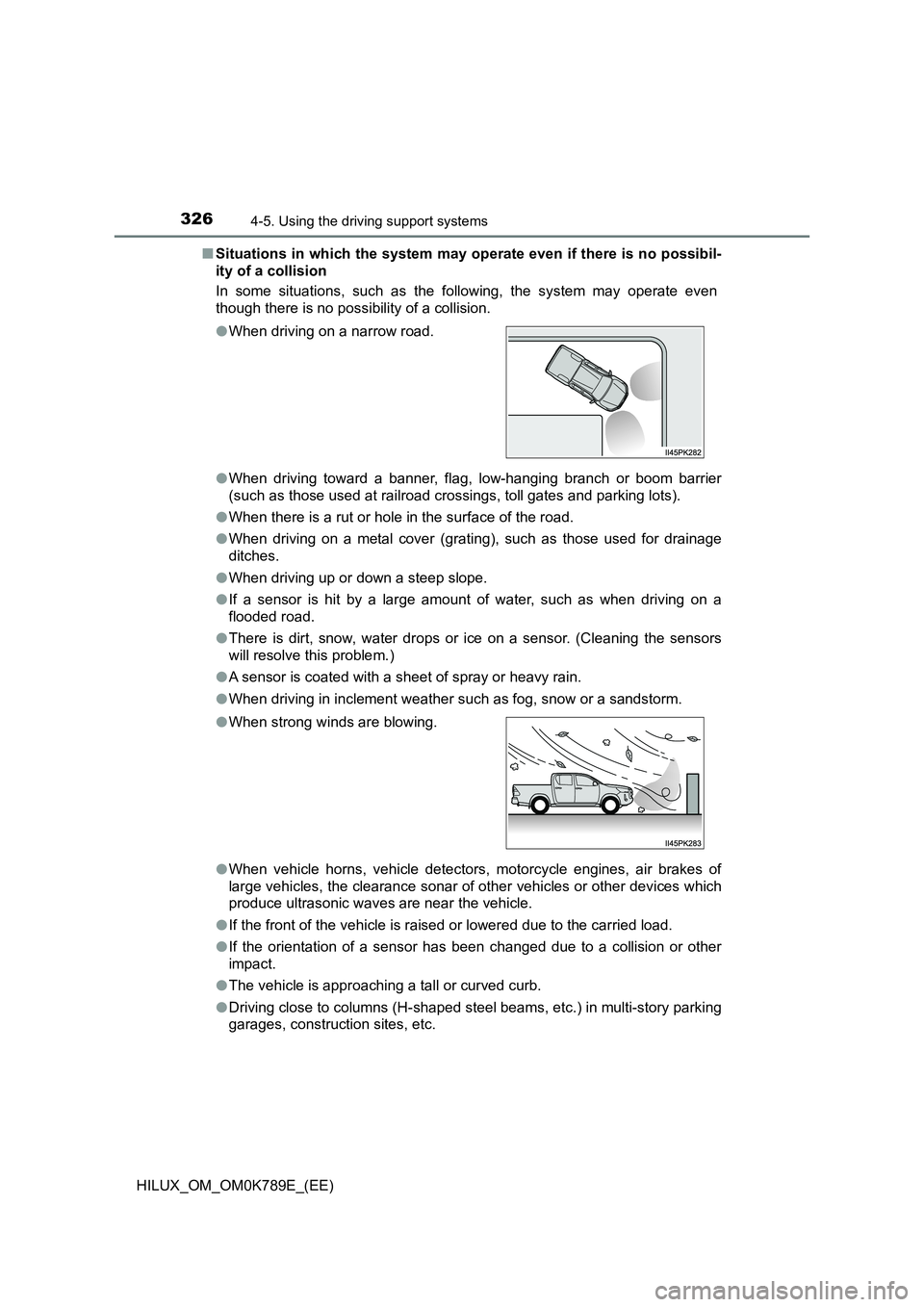
3264-5. Using the driving support systems
HILUX_OM_OM0K789E_(EE)
■ Situations in which the system may operate even if there is no possibil-
ity of a collision
In some situations, such as the following, the system may operate even
though there is no possibility of a collision.
● When driving toward a banner, flag, low-hanging branch or boom barrier
(such as those used at railroad crossings, toll gates and parking lots).
● When there is a rut or hole in the surface of the road.
● When driving on a metal cover (grating), such as those used for drainage
ditches.
● When driving up or down a steep slope.
● If a sensor is hit by a large amount of water, such as when driving on a
flooded road.
● There is dirt, snow, water drops or ice on a sensor. (Cleaning the sensors
will resolve this problem.)
● A sensor is coated with a sheet of spray or heavy rain.
● When driving in inclement weather such as fog, snow or a sandstorm.
● When vehicle horns, vehicle detectors, motorcycle engines, air brakes of
large vehicles, the clearance sonar of ot her vehicles or other devices which
produce ultrasonic waves are near the vehicle.
● If the front of the vehicle is raised or lowered due to the carried load.
● If the orientation of a sensor has been changed due to a collision or other
impact.
● The vehicle is approaching a tall or curved curb.
● Driving close to columns (H-shaped steel beams, etc.) in multi-story parking
garages, construction sites, etc.
● When driving on a narrow road.
● When strong winds are blowing.
Page 345 of 810
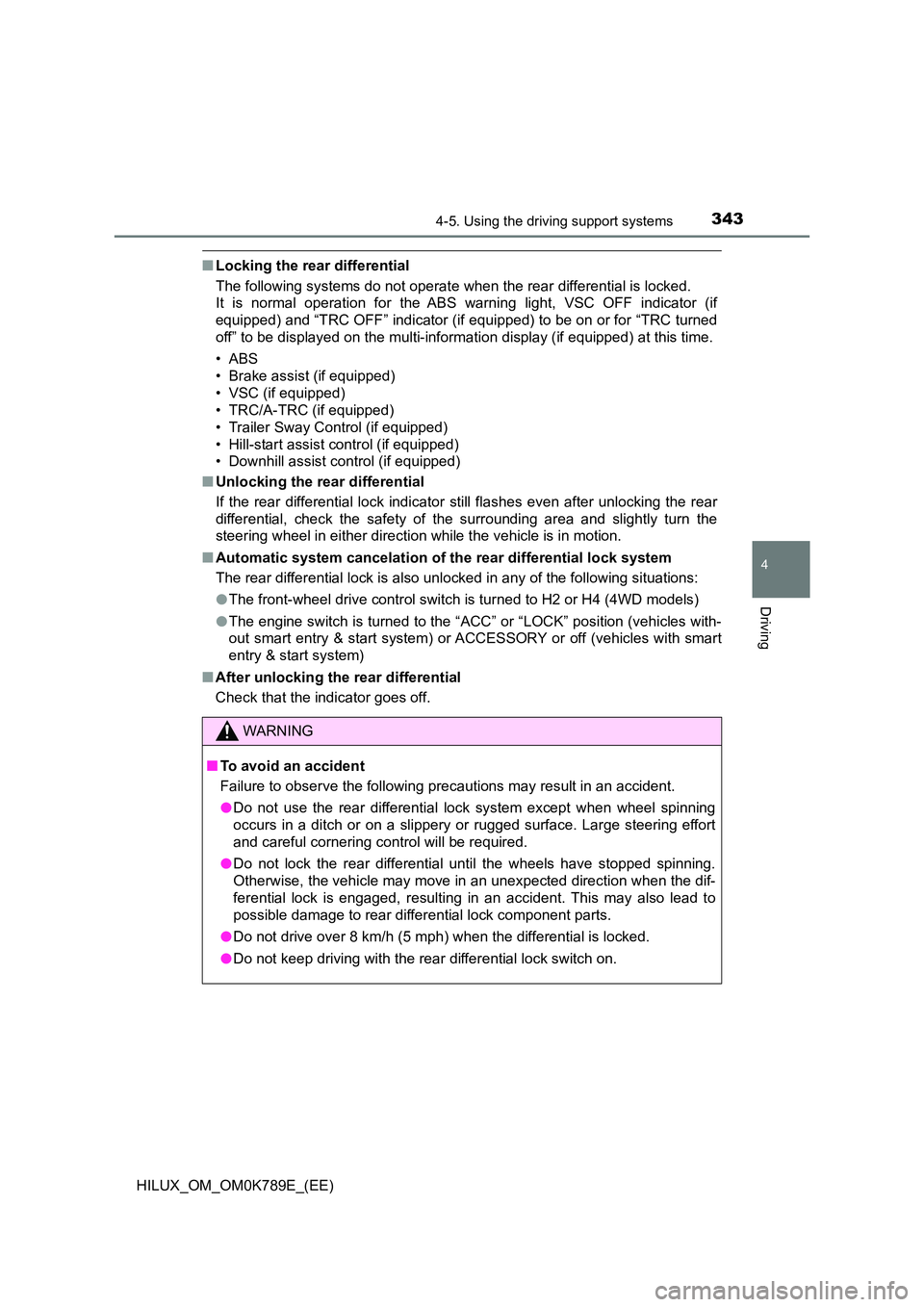
3434-5. Using the driving support systems
4
Driving
HILUX_OM_OM0K789E_(EE)
■Locking the rear differential
The following systems do not operate w hen the rear differential is locked.
It is normal operation for the ABS warning light, VSC OFF indicator (if
equipped) and “TRC OFF” indicator (if equipped) to be on or for “TRC turned
off” to be displayed on the multi-information display (if equipped) at this time.
•ABS
• Brake assist (if equipped)
• VSC (if equipped)
• TRC/A-TRC (if equipped)
• Trailer Sway Control (if equipped)
• Hill-start assist control (if equipped)
• Downhill assist control (if equipped)
■ Unlocking the rear differential
If the rear differential lock indicator still flashes even after unlocking the rear
differential, check the safety of the surrounding area and slightly turn the
steering wheel in either direction while the vehicle is in motion.
■ Automatic system cancelation of the rear differential lock system
The rear differential lock is also unlocked in any of the following situations:
● The front-wheel drive control switch is turned to H2 or H4 (4WD models)
● The engine switch is turned to the “ACC” or “LOCK” position (vehicles with-
out smart entry & start system) or A CCESSORY or off (vehicles with smart
entry & start system)
■ After unlocking the rear differential
Check that the indicator goes off.
WARNING
■ To avoid an accident
Failure to observe the following precautions may result in an accident.
● Do not use the rear differential lock system except when wheel spinning
occurs in a ditch or on a slippery or rugged surface. Large steering effort
and careful cornering control will be required.
● Do not lock the rear differential until the wheels have stopped spinning.
Otherwise, the vehicle may move in an unexpected direction when the dif-
ferential lock is engaged, resulting in an accident. This may also lead to
possible damage to rear differential lock component parts.
● Do not drive over 8 km/h (5 mph) when the differential is locked.
● Do not keep driving with the rear differential lock switch on.
Page 346 of 810
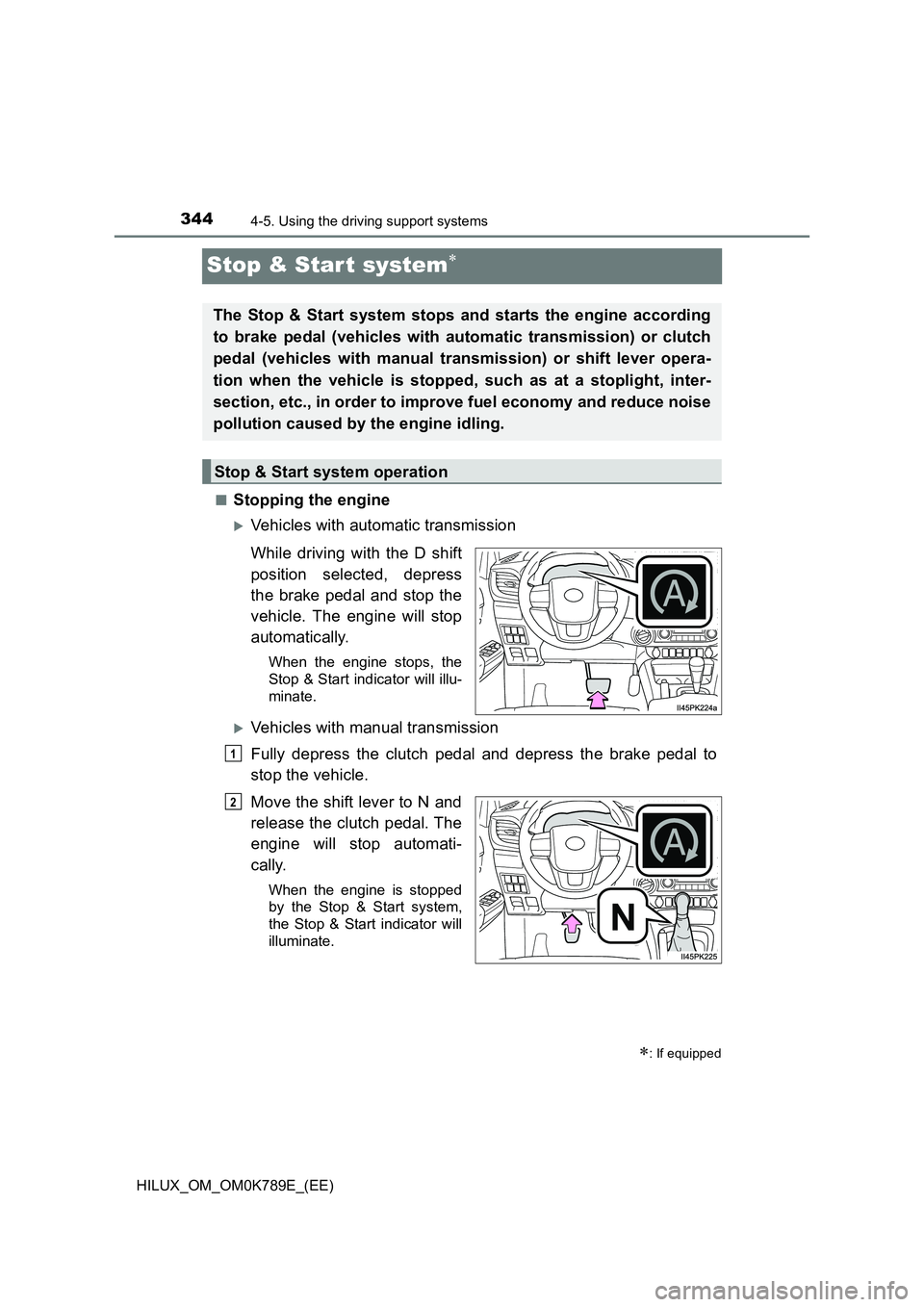
3444-5. Using the driving support systems
HILUX_OM_OM0K789E_(EE)
Stop & Star t system
■Stopping the engine
Vehicles with automatic transmission
While driving with the D shift
position selected, depress
the brake pedal and stop the
vehicle. The engine will stop
automatically.
When the engine stops, the
Stop & Start indicator will illu-
minate.
Vehicles with manual transmission
Fully depress the clutch pedal and depress the brake pedal to
stop the vehicle.
Move the shift lever to N and
release the clutch pedal. The
engine will stop automati-
cally.
When the engine is stopped
by the Stop & Start system,
the Stop & Start indicator will
illuminate.
: If equipped
The Stop & Start system stops and starts the engine according
to brake pedal (vehicles with automatic transmission) or clutch
pedal (vehicles with manual transmission) or shift lever opera-
tion when the vehicle is stopped, such as at a stoplight, inter-
section, etc., in order to improve fuel economy and reduce noise
pollution caused by the engine idling.
Stop & Start system operation
1
N
2
Page 347 of 810
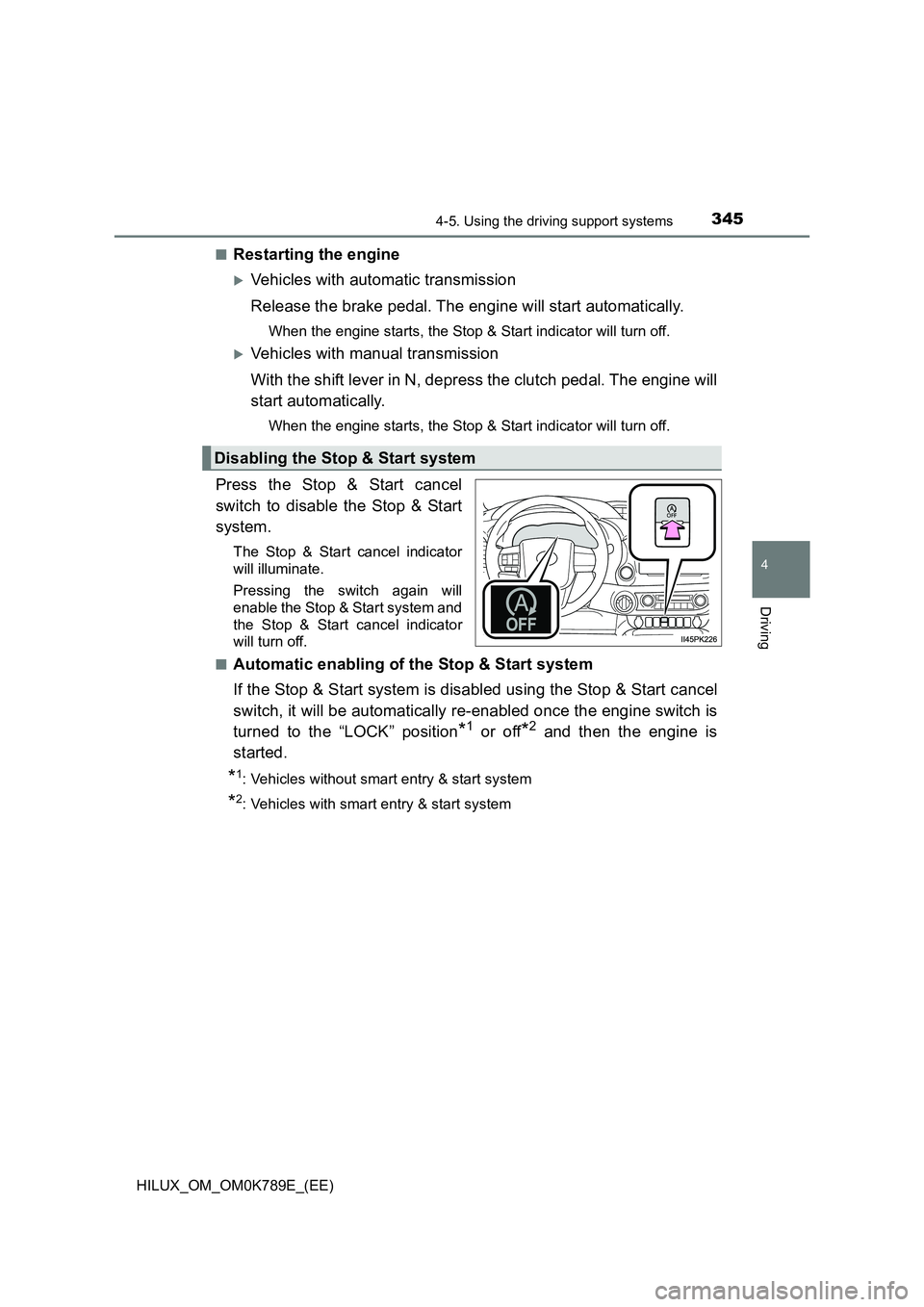
3454-5. Using the driving support systems
4
Driving
HILUX_OM_OM0K789E_(EE)
■Restarting the engine
Vehicles with automatic transmission
Release the brake pedal. The engine will start automatically.
When the engine starts, the Stop & Start indicator will turn off.
Vehicles with manual transmission
With the shift lever in N, depress the clutch pedal. The engine will
start automatically.
When the engine starts, the Stop & Start indicator will turn off.
Press the Stop & Start cancel
switch to disable the Stop & Start
system.
The Stop & Start cancel indicator
will illuminate.
Pressing the switch again will
enable the Stop & Start system and
the Stop & Start cancel indicator
will turn off.
■Automatic enabling of the Stop & Start system
If the Stop & Start system is disabled using the Stop & Start cancel
switch, it will be automatically re-enabled once the engine switch is
turned to the “LOCK” position*1 or off*2 and then the engine is
started.
*1: Vehicles without smart entry & start system
*2: Vehicles with smart entry & start system
Disabling the Stop & Start system
Page 348 of 810

3464-5. Using the driving support systems
HILUX_OM_OM0K789E_(EE)
When the engine is stopped by the Stop & Start system when the
vehicle is on an incline, when the brake pedal is released, brake force
is temporarily maintained to prevent the vehicle from rolling back-
wards before the engine is restarted and drive force is generated.
When drive force is generated, the maintained brake force is automat-
ically canceled.
● This function operates on flat surfaces as well as steep inclines.
● Sound may be generated from the brake system, but this does not
indicate a malfunction.
● Brake pedal response may change and vibration may occur, but
this does not indicate a malfunction.
■ Points for use
● If the engine switch is pressed when the engine is stopped by the Stop &
Start system, the engine will not be able to be restarted by the automatic
engine start function. In this case, restart the engine using the normal
engine starting procedure. ( P. 219, 222)
● When the engine is being restarted by the Stop & Start system, the power
outlets may be temporarily unusable, but this does not indicate a malfunc-
tion.
● Installation and removal of electrical components and wireless devices may
affect the Stop & Start system. Contact any authorized Toyota retailer or
Toyota authorized repairer, or any reliable repairer for details.
● When stopping the vehicle for a longer period of time, turn the engine switch
to the “LOCK” position*1 or off*2 to stop the engine completely.
● When the engine is restarted by the Stop & Start system, the steering wheel
may temporarily feel heavy.
● 4WD models only: While driving in L4 mode, it is recommended that the
Stop & Start system be canceled because the system may not operate prop-
erly.
*1: Vehicles without smart entry & start system
*2: Vehicles with smart entry & start system
Hill-start assist control (vehicles with automatic transmission)
Page 349 of 810

3474-5. Using the driving support systems
4
Driving
HILUX_OM_OM0K789E_(EE)
■ Operating conditions
● The Stop & Start system is operational when all of the following conditions
are met:
• The vehicle has been driven a certain amount of time.
• The brake pedal is being depressed firmly. (vehicles with automatic trans-
mission)
• The clutch pedal is not depressed. (vehicles with manual transmission)
• The D shift position is selected. (v ehicles with automatic transmission)
• The shift lever is in N. (vehicles with manual transmission)
• The driver’s seat belt is fastened.
• The driver’s door is closed.
• The selected driving mode is normal or Eco drive mode. (if equipped)
• The rear differential is not locked. (if equipped)
• is off. (vehicles without manual air conditioning system)
• The accelerator pedal is not being depressed. (vehicles with automatic
transmission)
• The engine is adequately warmed up.
• The outside temperature is -5°C (23°F) or higher.
• The hood is closed. ( P. 348)
● In the following situations, the engine may not be stopped by the Stop &
Start system. This is not a malfunction of the Stop & Start system.
• When the air conditioning system is being used.
• When the power heater is being used.
• When the battery is undergoing a periodic recharge.
• When the battery is not sufficiently charged, such as if the vehicle has
been parked for a long time and the battery charge has decreased, the
electric load is large, the battery fluid temperature is excessively low or
the battery has deteriorated.
• When the brake booster vacuum is low.
• When the elapsed time since the engine was restarted is short.
• When the vehicle is stopped frequently, such as when in a traffic jam.
• When the engine coolant temperature or transmission fluid temperature
is extremely low or high.
• When the vehicle is stopped on a steep incline. (vehicles with automatic
transmission)
• When the steering wheel is being operated.
• When the vehicle is being driven in a high altitude area.
• When the battery fluid temperature is extremely low or high.
• For a while after the battery terminals have been disconnected and
reconnected.